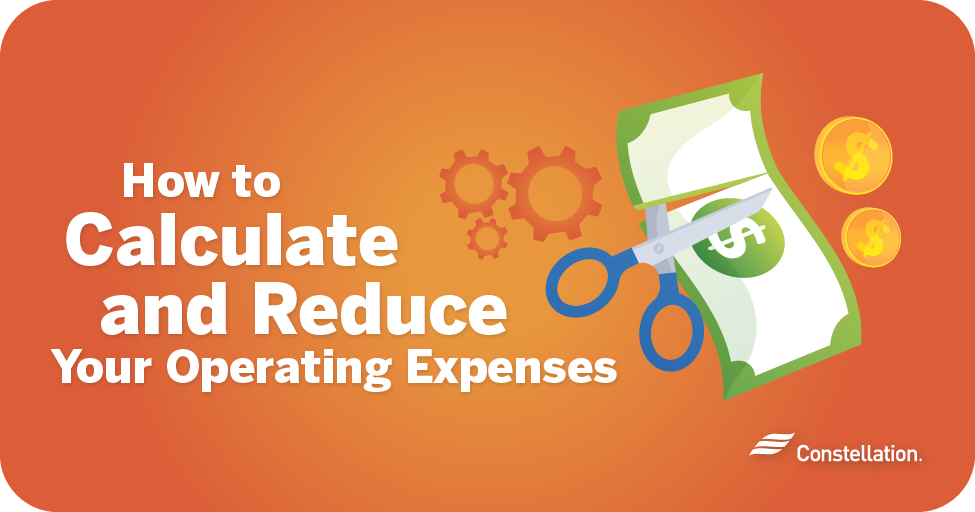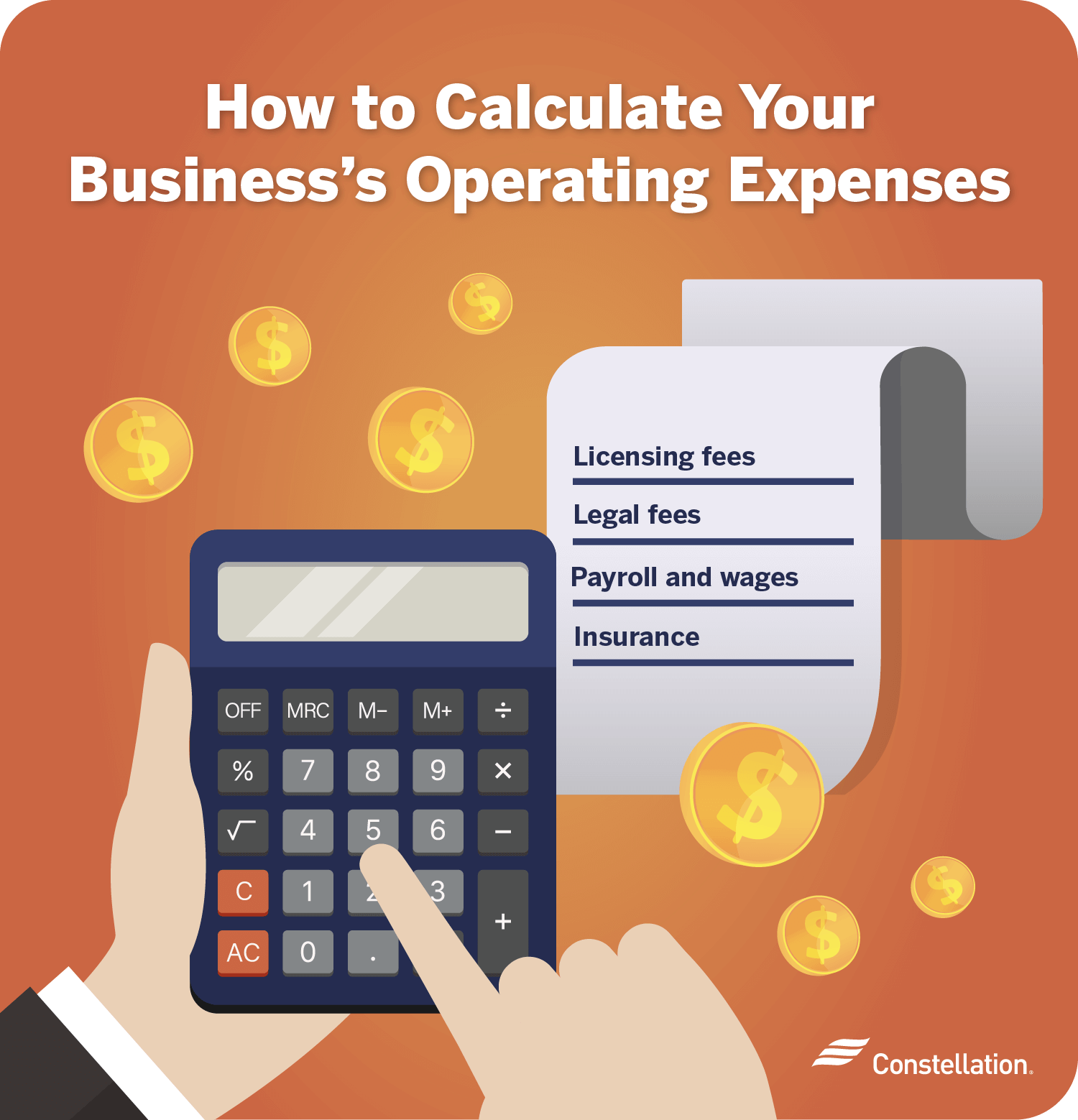
- Category:
Small Business Energy Savings -
Last updated:
August 15, 2022
How to Calculate and Reduce Your Operating Expenses
Understanding how to calculate operating expenses and finding effective operational cost reduction strategies have always been important to well-run businesses. In today’s tougher economic climate and with uncertainty in many industries, keeping tabs on the costs to run your business is critical to the financial health and success of your company.
- What is an operating expense?
- What’s included in my small business’s operating expenses?
- Calculate your business’s operating expenses
- Strategies to reduce operational costs and expenses for your business
- How Constellation can help your small business save on operating expenses
What is an operating expense?
It costs money to run a business. These costs are your operating expenses. They typically include rent or mortgage payments for your place of business, the cost of buying or renting equipment, maintenance expenses, what you pay for inventory, as well as spending on marketing, payroll, insurance, electricity and other utilities.
Before you can reduce operating expenses in business, you will need to estimate your spend. We make it easy to estimate utility costs and take steps to lower your small business utility bills. You can categorize past expenses and average them by year to get a good idea of what it’s been costing to run your business–and to track your spending trends.
What’s included in operating expenses for small businesses?
The categories of expenses to track will vary by business and industry As you go through your books to find operating expenses, consider these most common ones when figuring out how to calculate expenses:
- Rent
- Payroll and other employee expenses
- Travel and business entertainment
- Utilities
- Insurance
- Maintenance and repairs
- Property taxes
- Office supplies
- Asset depreciation
- Sales, marketing and advertising
How to calculate your business’s operating expenses

Use an operating expenses formula to get a clear view of your situation. These two are particularly useful for calculating the cost structure and efficiency of your business. They can serve as a guide and a scorecard as you work to reduce operating expenses in your business.
Operating expenses = (Rent + Payroll and other employee expenses + Travel and business entertainment + Utilities + Insurance + Maintenance and repairs + Property taxes + Office supplies + Asset depreciation + Sales, marketing and advertising)
What is the average operating expense ratio?
The operating expense ratio is calculated using a formula that measures the financial health of your company. It shows your costs as a percentage of your revenue. That makes it easy to compare your operations with other companies, no matter their industry or size.
A small number means you are using a smaller portion of your revenue to cover your operations. If the number is large, you may be burning through too much of your revenue just to keep the doors open.
[(Cost of Goods Sold) + (Operating Expenses)] / Revenue = Operating Expense Ratio (OER)
Calculate your operating profit
Another important operating expenses formula is this one that measures how much profit your company makes. Subtract the cost of what you sell, operating expenses and amortization from your revenues.
Operating Profit = (Revenues – Cost of Goods Sold – Operating Expenses – Amortization).
7 strategies to reduce operational costs and expenses for your business
Now that you know how to calculate operating expenses, here are some operational cost reduction ideas that can improve the efficiency and profitability of your business.

1. Automate tasks by using technology
Automation can contribute to operational cost reductions by saving time and reducing manpower. Advances in technology make automation easy and accessible to small businesses.
- Use accounting software for payroll. Save your bookkeeper and accountant for more important tasks. Use accounting software to organize and automate payroll without paying staff to do it.
- Use free marketing tools. Using free martech from companies like HootSuite that automates posting to Facebook, LinkedIn, Twitter and other social media. Companies like Yext automate business listings on Google My Business and other directories. You can boost your marketing reach with little effort and cost.
- Switch communication tools. Email isn’t the most efficient way to work. Slack and Google Drive facilitate collaboration and eliminate the need to file and store paper records. Take advantage of the small business benefits of cloud computing.
2. Reduce electricity costs by using green energy and smart appliances
After picking a solid electricity vendor and selecting the contract that saves you the most money, you can further cut your power bill by being more efficient. Reduce energy usage by unplugging appliances and electronics when not in use. Reap the benefits of smart lighting by transitioning to a smart workplace with energy efficient lights that you control and optimize. It isn’t as hard as you think for your small business to go green to reduce operating expenses as you promote a healthy planet.
3. Identify inefficiencies within your business
Shopping for lower prices, better terms and good vendors are a great start for operational cost reductions. You can also identify inefficiencies in your business.
Perhaps you are paying for unused subscriptions, tools and equipment that you don’t need or professional services retainers that might be better paid on an as-needed basis. You may also find you have recurring payments for separate services that can be combined for a lower price bundle.
Energy expenses are one area where understanding the factors that influence energy costs can pay off in the form of lower bills. Being efficient when it comes to energy consumption also helps. In today’s inflationary economy and with so much disruption, pay attention to trends to avoid unforeseen business costs.
4. Find alternative ways to increase cash flow
Lowering operating expenses is only half of your profit equation. While cutting costs, also look for ways to speed up cash flow and increase the revenue coming in. You can sell unused equipment, cut prices to move out old inventory, earn discounts for early payment and potentially increase prices for items in high demand.
5. Normalize remote work
Remote work can improve profitability, as you don’t need to pay for the space, electricity, and extras that on-site workers need. You can also source workers from locations with lower wages and slash your payroll.
6. Find the right vendors
It pays to shop around when it comes to finding operating expenses to cut. The right vendor can make a big difference. While comparing prices is relatively straightforward, you might save considerably more if you can specify the right terms.
Buying electricity, for example, isn’t just about price. You can find contracts that lock in electricity costs, that offer discounts for using energy off peak and for buying renewable energy. Buying in bulk, sharing space to cut rent, and other savings can be found across your operating expense categories.
7. Outsource when necessary
Outsourcing certain tasks is another way to reduce operating expenses in business. Many companies make outsourcing easy and turn-key whether off-shoring in distant countries or near-shoring to areas that are cheaper, but closer to your location. Outsourcing customer service, marketing, legal tasks, bookkeeping and accounting are all now common.
How Constellation can help you save in the long run
For many companies, energy is one of the major operating expenses. Reducing your energy bill will contribute to operational cost reductions. Constellation offers advice, products and programs that help you control and reduce operating expenses. We can help you save money now and in the long run–and operate a company that is efficient and environmentally sustainable.




